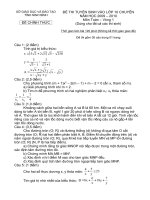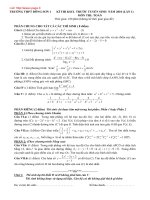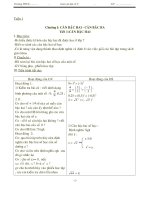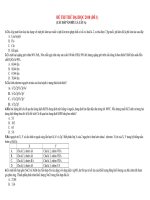2010 file 1
Bạn đang xem bản rút gọn của tài liệu. Xem và tải ngay bản đầy đủ của tài liệu tại đây (414.9 KB, 58 trang )
Chapter 11 – Cardiovascular Physiology and Anesthesia
DIRECTIONS (Questions 915 through 994): Each of the questions or incomplete statements
in this section is followed by answers or by completions of the statement, respectively. Select
the ONE BEST answer or completion for each item.
915. A 67-year-old man is to undergo a radical retropubic prostatectomy. He has aortic stenosis
with a gradient of 37 mm Hg at rest. He has an allergy to penicillin. Which of the following
is the best regimen for subacute bacterial endocarditis (SBE) prophylaxis in this patient?
A. Ampicillin and gentamicin
B. Vancomycin and gentamicin
C. Clindamycin and gentamicin
D. Clindamycin alone
E. None of the above
916. A 68-year-old patient is undergoing elective coronary revascularization. Just before
cardiopulmonary bypass, the hemoglobin concentration is 8.3 g/dL and platelet count is
253,000/mm3. After cardiopulmonary bypass is initiated, the patient is cooled to 20° C and
2 units of packed red blood cells (RBCs) are transfused because of bleeding. During
bypass, the anesthesiologist notices that the platelet count is 10,000/mm3 and the
hemoglobin concentration is 8 g/dL. The most likely cause of thrombocytopenia is
A. Sequestration
B. Hemolytic transfusion reaction
C. Dilutional thrombocytopenia
D. Disseminated intravascular coagulation
E. Heparin-induced thrombocytopenia
917. Which of the following is the most sensitive indicator of left ventricular myocardial
ischemia?
A. Wall-motion abnormalities on the echocardiogram
B. ST-segment changes in lead V5 of the electrocardiogram (ECG)
C. Appearance of V waves on the pulmonary capillary wedge pressure tracing
D. Elevation of the pulmonary capillary wedge pressure
E. Decrease in cardiac output as measured by the thermodilution technique
918. Oxygen consumption (VO2) is measured in a 70-kg subject on a treadmill at 2500 mL per
minute. This corresponds to:
A. 1 metabolic equivalent (MET)
B. 5 METs
C. 10 METs
D. 15 METs
E. 20 METs
919. Accidental injection of air into a peripheral vein would be LEAST likely to result in arterial
air embolism in a patient with which of the following anatomic cardiac defects?
A. Patent ductus arteriosus
B. Eisenmenger’s syndrome
C. Teratology of Fallot
D. Pulmonary atresia with ventricular septal defect
E. Tricuspid atresia
920. Each of the following could be placed on the x-axis of the curve shown in the figure
EXCEPT
A. Stroke volume
B. Left ventricular end-diastolic pressure
C. Left ventricular end-diastolic volume
D. Left atrial pressure
E. Pulmonary artery occlusion pressure
921. The ECG rhythm strip below represents
A. Atrial flutter
B. Third-degree heart block
C. Sinus tachycardia second-degree heart block
D. Malfunctioning DDD pacemaker
E. Junctional rhythm
922. A 71-year-old man is undergoing revascularization of three coronary vessels on
cardiopulmonary bypass at 28° C. After the first gr aft is sewn into the aorta, the arterial
pressure measured from a left radial artery is 47 mm Hg and the pulmonary artery
pressure is 6 mm Hg. Thirty minutes later, the arterial pressure is 52 mm Hg and
pulmonary artery pressure is 31 mm Hg. The most likely explanation for this is
A. Malposition of the aortic cannula
B. Malposition of the venous cannula
C. Faulty ventricular venting
D. Bypass associated sympathetic nervous system stimulation
E. Pulmonary artery catheter migration
923. A78-year-old patient is anesthetized for right hemicolectomy with isoflurane and nitrous
oxide. Vecuronium is administered to facilitate muscle relaxation. At the end of the
operation, the neuromuscular blockade is reversed with neostigmine 4 mg and
glycopyrrolate 0.8 mg. The rhythm below is noted shortly after administration of these
drugs. The patient’s blood pressure is 90/60. The most appropriate course of action at this
point is
A. DC cardioversion
B. Isoproterenol drip
C. Atropine
D. Transcutaneous pacemaker
E. Begin chest compressions
924. While on cardiopulmonary bypass during elective coronary artery revascularization, the
patient is noted to have bulging sclerae. Mean arterial pressure is 50 mm Hg, temperature
is 28° C, and there is no ECG activity. The most ap propriate action to take at this time is to
A. Administer mannitol, 50 gm IV
B. Administer furosemide, 20 mg IV
C. Decrease the cardiac index
D. Check the position of the aortic cannula
E. Check the position of the venous return cannula
925. Which of the following correctly describes the effect of transposition of the great vessels on
the rate of induction of anesthesia?
A. Inhalation induction is faster than normal; intravenous induction is slower than normal
B. Inhalation induction is slower than normal; intravenous induction is faster than normal
C. Both inhalation and intravenous induction are faster than normal
D. Both inhalation and intravenous induction are slower than normal
E. Inhalation induction is normal; intravenous induction is faster than normal
926. Anastomosis of the right atrium to the pulmonary artery (Fontan procedure) is a useful
surgical treatment for each of the following congenital cardiac defects EXCEPT
A. Tricuspid atresia
B. Hypoplastic left heart syndrome
C. Pulmonary valve stenosis
D. Truncus arteriosus
E. Pulmonary artery atresia
927. By what percentage is tissue metabolic rate reduced during cardiopulmonary bypass at
30° C?
A. 10%
B. 25%
C. 50%
D. 75%
E. 90%
928. Effective inflation of an intra-aortic balloon catheter should occur at which of the following
times?
A. Immediately after P wave on ECG
B. Immediately after closure of aortic valve
C. During opening of the aortic valve
D. During systolic upstroke on arterial tracing
E. At midpoint of QRS complex
929. Afterload reduction is beneficial during anesthesia for noncardiac surgery in patients with
each of the following conditions EXCEPT
A. Aortic insufficiency
B. Mitral regurgitation
C. Tetralogy of Fallot
D. Congestive heart failure
E. Patent ductus arteriosus
930. Administration of protamine to a patient who has not received heparin can result in
A. Anticoagulation
B. Hypercoagulation
C. Profound bradycardia
D. Seizure
E. Hypertension
931. The primary determinants of myocardial O2 consumption, from most to least important, are
A. Preload > afterload > heart rate
B. Heart rate > preload > afterload
C. Afterload > preload > heart rate
D. Heart rate > afterload > preload
E. Afterload > heart rate > preload
932. Cardiac tamponade is associated with
A. Pulsus alternans
B. Pulsus tardus
C. Pulsus parvus
D. Pulsus paradoxus
E. Bisferiens pulse
933. Which of the following drugs should NOT be administered via an endotracheal tube?
A. Lidocaine
B. NaHCO3
C. Atropine
D. Naloxone
E. Epinephrine
934. The mean arterial pressure in a patient with a blood pressure of 180/60 mm Hg is
A. 90 mm Hg
B. 100 mm Hg
C. 110 mm Hg
D. 120 mm Hg
E. 130 mm Hg
935. Hypothyroidism and hyperthyroidism could develop in patients receiving which of the
following antidysrhythmic drugs?
A. Amiodarone
B. Verapamil
C. Phenytoin
D. Lidocaine
E. Procainamide
936. Calculate the systemic vascular resistance (in dynes/sec/cm–5) from the following data:
cardiac output 5.0 L/min, central venous pressure 8 mm Hg, mean arterial blood pressure
86 mm Hg, mean pulmonary arterial blood pressure 20 mm Hg, pulmonary capillary wedge
pressure 9 mm Hg, heart rate 85 beats/min, patient weight 100 kg.
A. 750
B. 1000
C. 1250
D. 1500
E. Cannot be calculated
937. Which of the following is NOT included in tetralogy of Fallot?
A. Patent ductus arteriosus
B. Right ventricular hypertrophy
C. Ventricular septal defect
D. Overriding aorta
E. Pulmonic stenosis
938. A 65-year-old female patient with sepsis is undergoing an emergency exploratory
laparotomy. After induction of anesthesia and tracheal intubation, the patient’s blood
pressure is noted to be 65 systolic with a heart rate of 120 beats/min. Cardiac output
determined by a thermodilution pulmonary artery catheter is 13 L/min. Of the following
vasopressors the LEAST appropriate choice would be
A. Dobutamine
B. Dopamine
C. Norepinephrine
D. Epinephrine
E. Phenylephrine
939. Characteristics of ß2 stimulation include each of the following EXCEPT
A. Inhibition of insulin secretion
B. Glycogenolysis
C. Gluconeogenesis
D. Renin secretion
E. Uterine relaxation
940. A 61-year-old male patient with hypertropic cardiomyopathy is scheduled for left ventricular
myectomy under general anesthesia. Which of the following anesthetics would provide the
most stable hemodynamics in this patient?
A. N2O-narcotic
B. Ketamine
C. Halothane
D. Sevoflurane
E. Isoflurane
941. A healthy 59-year-old, 60-kg woman with a normal preoperative ECG develops wide
complex tachycardia under general anesthesia for breast biopsy. Blood pressure is 81/47
mm Hg and heart rate is 220 beats/min and regular. The most appropriate therapy would
be
A. Electrical cardioversion
B. Administration of lidocaine, 60 mg IV
C. Administration of procainamide, 20 mg/min IV
D. Administration of amiodarone, 300 mg IV
E. Adenosine, 6 mg IV
942. Although ß-adrenergic receptor blockade is the best treatment for reentrant
tachydysrhythmia associated with Romano-Ward syndrome, these dysrhythmias can also
be effectively treated with
A. Lidocaine
B. Procainamide
C. Quinidine
D. Left stellate ganglion blockade
E. Right stellate ganglion blockade
943. A 64-year-old patient with an axial flow left ventricular assist device (HeartMate II, Jarvik
2000) is scheduled for laparoscopic cholecystectomy under general anesthesia.
Monitoring which of the following parameters is likely to be difficult in this patient?
A. Blood pressure with blood pressure cuff
B. Blood pressure with arterial line
C. Pulmonary artery pressure with pulmonary artery (PA) catheter
D. Temperature with esophageal temperature probe
E. End tidal isoflurane concentration with mass spectrometer
944. In a normal person, what percentage of the cardiac output is dependent on the “atrial
kick”?
A. 25%
B. 35%
C. 45%
D. 55%
E. 65%
945. This arterial waveform is consistent with
A. Aortic regurgitation
B. Aortic stenosis
C. Cardiac tamponade
D. Hypovolemia
E. Severe diastolic dysfunction
946. A 1-year-old child with tetralogy of Fallot is to undergo elective repair of a left inguinal
hernia under general anesthesia. Which of the following anesthetics would provide the
most stable hemodynamics in this patient?
A. Sevoflurane and N2O
B. Isoflurane and N2O
C. Desflurane and oxygen
D. Fentanyl and N2O
E. Ketamine
947. The left ventricular pressure-volume loop shown in the figure depicts
A. Mitral stenosis
B. Mitral regurgitation
C. Aortic stenosis
D. Acute aortic insufficiency
E. Chronic aortic insufficiency
948. A 54-year-old patient is undergoing a three-vessel coronary artery bypass graft under
general anesthesia. After induction, the pulmonary capillary wedge pressure is 15 mm Hg
and pulmonary artery pressures are 26/13 mm Hg. Suddenly, new 30-mm Hg V waves
appear on the monitor screen. Systemic blood pressure is 120/70 mm Hg, heart rate is 75
beats/min, and pulmonary artery pressure is 50/35 mm Hg. Which of the following drugs
should be administered to the patient?
A. Nitroglycerin
B. Nitroprusside
C. Esmolol
D. Phenylephrine
E. Dobutamine
949. A 62-year-old patient scheduled for elective repair of an abdominal aortic aneurysm
develops a wide complex regular tachycardia (heart rate 150) during induction of
anesthesia. Blood pressure is 110/78. Which of the following drugs would be most useful
in the management of this dysrhythmia?
A. Lidocaine, 100 mg IV
B. Amiodarone, 150 mg IV over 10 minutes
C. Adenosine, 6 mg rapidly over 3 seconds
D. Verapamil, 5 to 10 mg IV
E. Esmolol, 35 mg IV
950. Under maximum stress, how much cortisol is produced per day?
A. 50 mg
B. 150 mg
C. 250 mg
D. 350 mg
E. Up to 1000 mg
951. A VVI pacemaker programmed to pace at a rate of 70 beats/min is noted on the
preoperative ECG to pace at 61 beats/min. The most likely reason for this decrease in the
pacing heart rate is
A. Decreased atrial rate
B. Third-degree heart block
C. Trifascicular heart block
D. Battery failure
E. Normal variation
952. Calculate the cardiac output from the following data: patient weight 70 kg, hemoglobin
concentration 10 mg/dL, arterial blood gases on 100% O2: PaO2 450 mm Hg, PaCO2 32
mm Hg, pH 7.46, SaO2 99%. Mixed venous blood gases are: PvO2 30 mm Hg, PaCO2 45
mm Hg, pH 7.32, SvO2 60%.
A. 2.5 L/min
B. 3.0 L/min
C. 3.5 L/min
D. 4.0 L/min
E. 4.5 L/min
953. Normal resting myocardial O2 consumption is
A. 2.0 mL/100 g/min
B. 3.5 mL/100 g/min
C. 10 mL/100 g/min
D. 15 mL/100 g/min
E. 25 mL/100 g/min
954. A 22-year-old man with hypertrophic cardiomyopathy (HOCM) is undergoing an elective
cholecystectomy under general anesthesia. Immediately after induction with thiopental, 5
mg/kg IV, the arterial blood pressure decreases from 140/82 to 70/40 mm Hg. What would
be the most appropriate drug for treatment of hypotension in this patient?
A. Ephedrine
B. Mephentermine
C. Isoproterenol
D. Phenylephrine
E. Epinephrine
955. A 65-year-old patient with moderate aortic stenosis develops a sudden increase in heart
rate during an appendectomy under general anesthesia. The ventricular rate is 190
beats/min and is irregularly irregular, arterial blood pressure is 70/45 mm Hg, and there is
2 mm ST-segment depression in lead V5 of the ECG. Which of the following would be the
most appropriate treatment for myocardial ischemia in this patient?
A. Electrical cardioversion
B. Esmolol
C. Nitroglycerin
D. Verapamil
E. Phenylephrine
956. After emergency repair of a ruptured abdominal aortic aneurysm, a 68-year-old patient is
mechanically ventilated in the intensive care unit with 20 cm H2O of positive end-expiratory
pressure (PEEP) for 3 days. Sodium nitroprusside has been infused at a rate of 1.5
µg/kg/min for 48 hours to control hypertension. Suddenly, the systemic blood pressure falls
from 130/70 to 50 mm Hg systolic and the SaO2 drops to 75%. The most likely cause of
this scenario is
A. Cyanide toxicity
B. Acute myocardial infarction
C. Tension pneumothorax
D. Hyperventilation
E. Methemoglobinemia
957. Normal resting coronary artery blood flow is
A. 10 mL/100 g/min
B. 40 mL/100 g/min
C. 75 mL/100 g/min
D. 120 mL/100 g/min
E. 160 mL/100 g/min
958. Each of the following is associated with an increased incidence of pulmonary artery
rupture in patients with pulmonary artery catheters EXCEPT
A. Hypothermia
B. Presence of pulmonary artery atheromas
C. Old age
D. Anticoagulation
E. Pulmonary artery catheter migration
959. Allergic reactions to protamine can occur with each of the following EXCEPT?
A. Diabetes treated with NPH insulin
B. Diabetes treated with regular insulin
C. Diabetics treated with PZI insulin
D. Previous vasectomy
E. Allergy to seafood
960. A 66-year-old patient is undergoing a three-vessel coronary artery bypass operation.
Anticoagulation is achieved with 20,000 units of heparin. How much protamine should be
administered to this patient to completely reverse the heparin after cardiopulmonary
bypass?
A. 150 mg
B. 250 mg
C. 350 mg
D. 450 mg
E. 550 mg
961. The graph below represents
A. Ventricular end-diastolic pressure as a function of ventricular end-diastolic volume
B. Stroke volume as a function of end-diastolic pressure
C. Cardiac index as a function of end-diastolic pressure
D. Cardiac output as a function of ventricular end-diastolic volume
E. Diastolic time (as percentage of cardiac cycle) as a function of heart rate
962. A 72-year-old woman is undergoing cardiopulmonary bypass for aortic and mitral valve
replacement. The surgery is uneventful; however, in the intensive care unit, blood is noted
to ooze from the pulmonary artery catheter and venous access sites. Mediastinal chest
tube output is 500 mL/hour. A thromboelastogram is obtained and shown in the figure.
What is the most likely cause of profuse bleeding in this patient?
A. Fibrinolysis
B. Excess heparin
C. Thrombocytopenia
D. Factor VIII deficiency
E. Poor surgical hemostasis
963. A 170-micrometer filter must be used for administration of each of the following EXCEPT
A. Fresh frozen plasma
B. Cryoprecipitate
C. Platelets
D. Packed red cells
E. Albumin
964. The dose of adenosine necessary to convert paroxysmal supraventricular tachycardia to
normal sinus rhythm should be initially reduced
A. In patients receiving theophylline for chronic asthma
B. In patients with a history of arterial thrombotic disease taking dipyridamole
C. In patients with a history of chronic renal failure
D. In patients with hepatic dysfunction
E. In chronic alcoholics
965. A 56-year-old male patient is anesthetized for elective coronary revascularization. A
urinary catheter is placed after induction and coupled to a temperature transducer. A
pulmonary artery catheter is inserted, and the temperature probe on the distal portion of
the catheter is also connected to a transducer. The reason for measuring the temperature
of both the bladder and the blood in the pulmonary vasculature is
A. Both are necessary for determining cardiac output by the thermodilution technique
B. Bladder temperature is more accurate prebypass; pulmonary artery catheter
temperature is more accurate postbypass
C. Pulmonary artery catheter temperature is more accurate prebypass; bladder
temperature is more accurate postbypass
D. It is helpful in determining the likelihood of recooling after discontinuation of
cardiopulmonary bypass
E. It is the average of these two temperatures, which is important in determining patient
body warmth
966. Which of the following would be the best intraoperative transesophageal echocardiograph
(TEE) view to monitor for myocardial ischemia?
A. Mid-esophageal 4 chamber view
B. Transgastric mid-papillary left ventricular short axis view
C. Mid-esophageal long axis view
D. Mid-esophageal 2 chamber view
E. Transgastric 2 chamber view
967. Select the true statement regarding CPR and defibrillation by a health care provider in
patients experiencing sudden cardiac arrest
A. Defibrillation times one should always precede CPR
B. CPR should always be carried out for 2 minutes prior to defibrillation
C. Two minutes of chest compressions alone (no ventilation) should be carried out prior
to first shock
D. If arrest less than 1 minute (witnessed) one biphasic shock then 5 cycles of CPR
E. If arrest less than 1 minute (witnessed) three biphasic shocks then 5 cycles of CPR
968. Which of the following medications blocks angiotensin at the receptor?
A. Losartan (Cozaar)
B. Terazosin (Hytrin)
C. Lisinopril (Prinivil, Zestril)
D. Spironolactone (Aldactone)
E. Amlodipine (Norvasc)
969. Untoward effects associated with administration of sodium bicarbonate during massive
blood transfusion include each of the following EXCEPT
A. Hyperosmolality
B. Paradoxical cerebrospinal fluid acidosis
C. Hypercarbia
D. Hypernatremia
E. Hyperkalemia
970. Useful therapy for hypercyanotic “tet spells” in patients with tetralogy of Fallot might
include any of the following EXCEPT
A. Esmolol
B. Lactated Ringer’s solution bolus (5 mL/kg)









